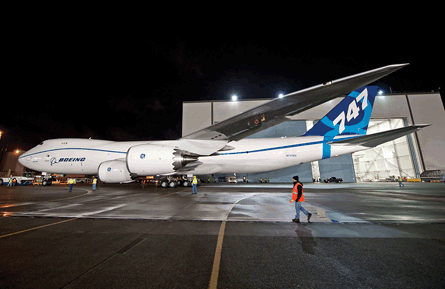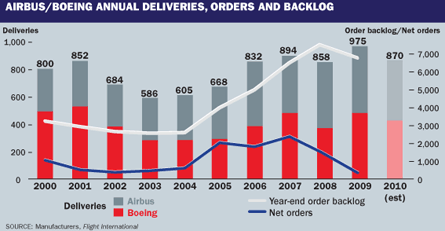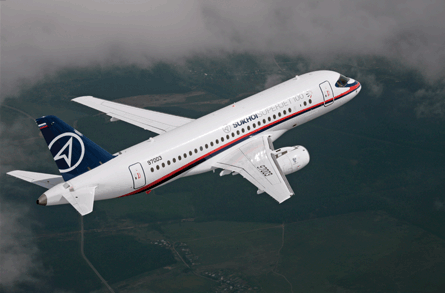The succession of boom years that faltered in 2008 came to a full stop in 2009, with Airbus and Boeing's net orders tumbling by 1,000 units from the 1,400 of the previous year.
With the world's economy only just showing signs of a recovery, the airframers' fortunes are unlikely to see a turnaround in 2010. But one or two major orders can still be expected as the likes of Emirates and United Airlines go shopping in "the sales" for some sporty deals.
"Most of the important economic and airline industry indicators are likely to be relatively flat in 2010, arguing for another slow year for orders," says Teal Group vice-president analysis Richard Aboulafia.
 |
|---|
© BoeingGetting the 747-8 into the air will be one of Boeing's 2010 priorities |
"Of course, with 7,000 on backlog, the industry shouldn't care about orders. The fact that it does shows that the current 7,000 don't mean much, and that, paradoxically, the goal of orders is seriously flawed. We need traffic and profits. And 2010 looks like a very slow recovery."
Next week Airbus will reveal whether it reached the sales target it set back in January 2009 of 300 gross orders for the year. By the end of the 11th month, the airframer's sales had reached 225, so that the full-year goal was just about within reach if it was able to get its usual flurry of deals signed off by year-end.
Boeing's 2009 fortunes in the order stakes were stymied by the high number of cancellations for the 787, which dragged down its net sales to around the 100-aircraft mark. This year it will be looking to shore up the remainder of the Dreamliner's backlog and underline its ability to meet its revised schedule with a successful flight-test programme without further delivery slips.
Neither manufacturer has issued detailed 2010 production guidance, but after output hit a record 970-plus units last year few would expect that level to be sustained in 2010.
"Production needed to come down a year ago," says Aboulafia. "The glut of narrowbodies is particularly worrying."
In defence of their ability to keep producing despite the economic turmoil, the airframers cite the "myth" that 2009 delivery financing would be a major issue. In reality the gap did not materialise on the scale forecast by some analysts. After talk of shortfalls as high as $20 billion, Boeing Capital (BCC) data shows that the manufacturers (Airbus, Boeing, Bombardier and Embraer) had to find just $2.5 billion of the $68 billion needed for 2009 deliveries.
 |
|---|
Much of the shortfall was made up by the government-run export credit agencies, which provided $21 billion - up 68% on the $12.5 billion in 2008.
Aboulafia says that while it is "fun for a while" for the airframers to use government-backed finance to support what he believes is overproduction, "with traffic not likely to make much of a recovery in 2010, build rates will start to come down in the second half of the year".
BCC estimates that in 2010 the airframers will have to provide a similar level of financial support, although it expects that the overall delivery funding requirement will fall 8% to $62 billion due to reduced production rates.
"We need traffic and profits. And 2010 looks like a very slow recovery"Richard AboulafiaTeal Group vice-president analysis |
Aboulafia believes that the two airframers should cut output by 10-15% this year, which would push the total deliveries to below 850 units. "But this industry is the ultimate lagging economic indicator. Production won't bottom out until 2011, or perhaps even 2012."
BCC's head of capital markets development, Kostya Zolotusky, argues that the airframers are maintaining high production in the face of the global slump because "the aircraft are needed", due to three fundamental dynamic changes.
He says: "The global balance of demand is broader; there is a greater diversity of airline business models than before - low cost leasing is a relevant counter-balance to the lack of demand from legacy carriers - and we are moving into a higher plateau of oil prices which necessitates a greater replacement requirement."
DELIVERY-SLOT SWAPS
This broadening of the "balance of demand" made 2009 the year of "delivery-slot swaps". Airlines in regions less affected by the slump - for example Gulf carriers Gulf Air, FlyDubai and Qatar Airways - were able to advance their schedules by taking over other airlines' airframes as they approached the end of the production line. This helped keep production up without the usual glut of white tails, but whether the airline industry will have the same appetite for this in 2010 remains to be seen.
In terms of civil programmes, Airbus and Boeing have fairly full "to-do" lists this year. Top of the US airframer's list is to push the 787 through flight-testing without further hitches, and to get the 747-8 in the air. Both aircraft are due for first deliveries by year-end - for now at least.
Meanwhile, Toulouse will start to see the fruits of its A350 XWB development effort as major sections of the first aircraft should start to come together at plants across Europe and the USA ahead of final assembly beginning early in 2011.
A more immediate priority is to complete flight-testing of the A330-200F and begin deliveries to Etihad Airways in the summer.
Sorting out A380 production is also a pressing requirement, as Airbus admits that the process of assembling and customising the super jumbo continues to take too long. Expect the airframer to implement more changes in Toulouse and Hamburg, sooner rather than later.
In terms of product development, there could be some key decisions taken by Airbus and Boeing in 2010, and all linked to engines. Both airframers look increasingly likely to develop re-engined versions of the current single-aisle products powered by one or more of the next generation turbofans in development by CFM International, Pratt & Whitney and Rolls-Royce. Potential developments could crystallise over the next 12 months as the engine makers firm up their own plans.
Any moves from the big two will increase the pressure on Bombardier to sign up more airlines for its CSeries small airliner, having so far only secured a deal from Lufthansa/Swiss and lessor LCI.
 |
|---|
© Sukhoi |
"It badly needs a second notable customer," says Aboulafia. "Despite the grim times, there's a good chance of someone signing up in 2010, but if Airbus and Boeing turn aggressive about re-engining their products in 2010, all bets are off on the CSeries."
Embraer is also evaluating a move into the CSeries space, but it too wants more clarity from the engine makers - and a better steer on the likely moves from Airbus and Boeing - before it commits. If this does happen in 2010, expect to see Embraer in the thick of it.
At the other end of the spectrum, Boeing seems to be coming under pressure to decide what it does about the adapting its successful 777 twinjet to be more effective against the A350. The airframer is examining various options from a refresh, a re-wing and an all-new aircraft, but the likelihood is that whatever it goes for will hinge on the availability of a new engine - probably from existing exclusive supplier GE.
Russia and China are gearing up to be right in the mix of the next generation single-aisle market, with both having all-new airliners in development that will be powered by next-generation powerplants from P&W and CFM respectively. More clarity should emerge on these programmes during 2010.
REGIONAL ARRIVALS
Down among the regionals, there should be a raft of new arrivals in 2010, the most notable of which will be the two brand-new airliners from Russia and China that are due to make their debuts - the Sukhoi Superjet 100 and Comac ARJ21. Both types had originally been due to enter service in 2009, but should now begin earning money this year.
Bombardier meanwhile will finally introduce what should be the last iteration of its big selling regional jet, the 100-seat CRJ1000, but will it prove to be as stretch too far?
 |
|---|
Source: Flight International























